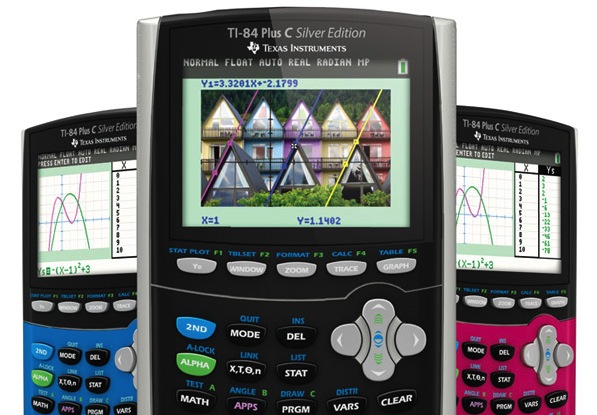
It was big news when Texas Instruments revealed it would finally upgrade one of its best-loved graphing calculators with a color screen next year, in large part because graphing calculators are near-stagnant pieces of technology, changing in only the tiniest increments since their introduction two decades ago. Why did TI wait so long? And after waiting so long, why now?
Graphing calculators have always been very simple machines, often featuring old Zilog Z80 or Motorola 68000 processors, a handful of kilobytes of user-accessible RAM, a 96x64 display, and a compartment for a few AAA batteries. But despite such ancient hardware profiles, math and science students and teachers have come to depend on them; a math student’s best friend in the world is, arguably, his calculator.
In 1990, Texas Instruments created its first graphing calculator, dubbed the TI-81, for use by students in high school math classes. The TI-82 followed, then the TI-83, then the TI-84... today, the TI-89 Titanium is the series flagship, sporting "apps" and a USB connector. In a few months, the TI-80 line will go color with the TI-84+C Silver, which follows in the footsteps of TI's separate TI-Nspire line with color displays from last year. The TI-84+C Silver's new hardware profile includes a 320x240 16-bit color display, 3.5MB of flash ROM, and 21KB of RAM—hardly cutting edge by smartphone standards, but high-end for a traditional graphing calculator. Yet the TI-80 line endures. How?
For one thing, the constraints of the graphing calculator are key selling points. They provide something of a known quantity when it comes to doing math, especially on standardized tests, where a fully programmable smartphone with Web access would not be allowed. (TI prominently displays a "Permitted on testing" logo alongside its calculators; many of its devices are explicitly green-lighted for use with the AP and SAT standardized tests.) The need for limits makes it difficult for TI to evolve its devices even a little without upsetting the balance. As Alexis Madrigal pointed out at The Atlantic last year, it’s not as if calculators need to keep pace with changing subject matter, either. “If the calculators were good enough for us 10 or 15 years ago, they are still good enough to solve the math problems,” he noted.
Still, the idea of paying $50 to $150 (or more) for a single-purpose device that your smartphone can run laps around makes us cringe. TVs went color 60 years ago; we carry around color screens in our pockets now. We couldn’t get that trivial feature in a simple 96x64 calculator screen until now?
Technology for technology's sake
Tysun McKay, director of communications and Web strategy at TI, told me that one of the reasons color calculators weren’t a priority for the company was that educators simply weren’t asking for them until recently.
“We don’t want to create technology for technology’s sake,” McKay said. She noted that one of TI’s priorities is maintaining the price of the calculator. A few years ago, teachers told the company that a color screen would be nice, but wouldn't be worth a higher purchase price, McKay said.

“We haven’t seen as much change in quite some time but it’s more exciting than it is a problem to see change," McKay said. "It’s letting us really think differently about 'how do we make sure students are excelling at math and science?'”
Battery life was also a concern with the new display, which takes more power. “It’s no big deal if my phone dies and I miss a phone call," said McKay. "It’s a pretty big deal if your calculator dies and you can’t answer some questions on a quiz.”
Last year, an article in the Washington Post pointed out that some classrooms were integrating tablets and smartphones into math classes rather than making students purchase dedicated calculators for around $100. One teacher even noted that students were learning math more quickly using their phones. Teachers may lose some consistency as students use different smartphone apps, but as long as each student has mastery of their app’s particular method to, say, plot an equation, the classroom experience can still hold up.
Lucas Allen, who writes the graphing calculator blog TechPoweredMath and uncovered the news of the TI-84+C Silver on the Cemetech forums, had a few more guesses about the new color calculator and why it might have taken so long to develop. “I don’t doubt that any of this could have been done a while ago,” Allen told Ars. “I really don’t think TI anticipated the excitement that a color TI-84 could produce.”
“Things move very slowly in the world of education,” he added, noting that sometimes department chairs in high schools or colleges need to retire before change can be effected. “Most of the leaders in the math education community have moved on from the TI-84,” Allen said, to the (literally) greener pastures of the TI-Nspire line. But there’s “still a very loyal camp” of TI-84 users, whether they’re academics or hackers homebrewing their own versions of Portal. For them, the TI-84’s incremental upgrade may be perfect—a way for things to change while, as much as possible, staying almost exactly the same.

reader comments
168